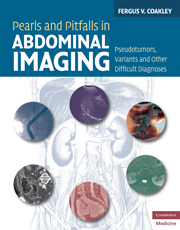Book contents
- Frontmatter
- Contents
- Preface
- Acknowledgements
- Section 1 Diaphragm and adjacent structures
- Section 2 Liver
- Section 3 Biliary system
- Section 4 Spleen
- Section 5 Pancreas
- Section 6 Adrenal glands
- Case 35 Minor adrenal nodularity or thickening
- Case 36 Adrenal pseudotumor due to gastric fundal diverticulum
- Case 37 Adrenal pseudotumor due to horizontal lie
- Case 38 Adrenal pseudotumor due to varices
- Case 39 Adrenal pseudoadenoma
- Section 7 Kidneys
- Section 8 Retroperitoneum
- Section 9 Gastrointestinal tract
- Section 10 Peritoneal cavity
- Section 11 Ovaries
- Section 12 Uterus and vagina
- Section 13 Bladder
- Section 14 Pelvic soft tissues
- Section 15 Groin
- Section 16 Bone
- Index
- References
Case 39 - Adrenal pseudoadenoma
from Section 6 - Adrenal glands
Published online by Cambridge University Press: 05 November 2011
- Frontmatter
- Contents
- Preface
- Acknowledgements
- Section 1 Diaphragm and adjacent structures
- Section 2 Liver
- Section 3 Biliary system
- Section 4 Spleen
- Section 5 Pancreas
- Section 6 Adrenal glands
- Case 35 Minor adrenal nodularity or thickening
- Case 36 Adrenal pseudotumor due to gastric fundal diverticulum
- Case 37 Adrenal pseudotumor due to horizontal lie
- Case 38 Adrenal pseudotumor due to varices
- Case 39 Adrenal pseudoadenoma
- Section 7 Kidneys
- Section 8 Retroperitoneum
- Section 9 Gastrointestinal tract
- Section 10 Peritoneal cavity
- Section 11 Ovaries
- Section 12 Uterus and vagina
- Section 13 Bladder
- Section 14 Pelvic soft tissues
- Section 15 Groin
- Section 16 Bone
- Index
- References
Summary
Imaging description
The normal steroid-producing cells of the adrenal cortex are rich in intracellular lipid because steroids are based on the cholesterol molecule. Adrenal adenomas are benign tumors derived from the adrenal cortex and also contain substantial amounts of intracellular lipid. Two of the critical imaging findings used to characterize adenomas are based on this fact; namely, adenomas are typically of low density (less than 10–18 Hounsfield Units) at non-enhanced CT and lose signal on opposed phase gradient-echo MRI when compared to in phase gradient-echo MRI [1, 2]. While both these signs are highly specific, there are some exceptions:
Fluid-filled cystic or necrotic masses can be of low density on non-enhanced CT (Figures 39.1 and 39.2) [3].
Other adrenal tumors can occasionally be rich in intracellular lipid, and demonstrate signal loss on opposed phase gradient-echo MRI, including adrenocortical carcinoma, metastases from primary tumors that contain intracellular lipid such as clear cell renal cell carcinoma or hepatocellular carcinoma (Figure 39.3), and pheochromocytoma [4–8].
Importance
The non-invasive characterization of adrenal adenomas by non-enhanced CT or opposed phase gradient-echo MRI is one of the major advances of modern genitourinary radiology, but erroneous diagnosis of an adenoma due to one of the rare exceptions detailed above could theoretically result in a missed opportunity for treatment of clinically important pathology, such as adrenocortical carcinoma or pheochromocytoma, or result in inappropriate treatment of the primary malignancy in the setting of unrecognized metastatic spread of clear cell renal cell carcinoma or hepatocellular carcinoma.
Information
- Type
- Chapter
- Information
- Pearls and Pitfalls in Abdominal ImagingPseudotumors, Variants and Other Difficult Diagnoses, pp. 130 - 133Publisher: Cambridge University PressPrint publication year: 2010
